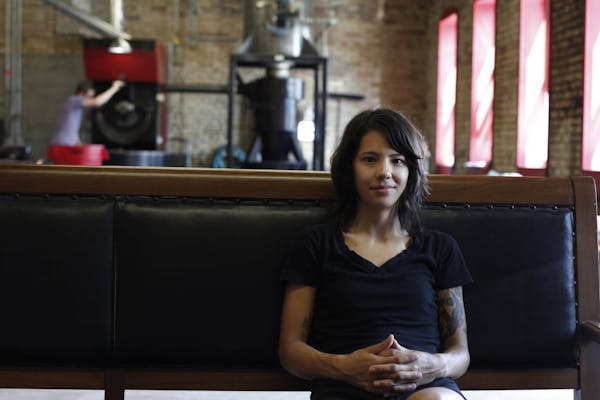Change has come to your neighborhood coffee shop. Maybe you've heard the names: Kopplin's, Dogwood, Angry Catfish, Urban Bean, Bull Run, Blue Ox.
Like craft beer and craft cocktails, coffee is experiencing an artisanal spring.
With that comes a new sense of intimidation for those of us who just figured out what "venti" means. Some of these small shops have a seriousness of purpose that easily can tip over into snobbish superiority.
Still, I find myself enamoured of the process -- the sourcing of the beans, the roasting, the slo-mo ritual of the "pour-over." All of which culminates in the thing that matters most: a better taste. It's like discovering Surly after drinking Miller Lite all your life.
The movement of expertly sourced beans and professional baristas began brewing last decade in such coffee-centric cities as Seattle and New York. Here in the Twin Cities, many point to Kopplin's in St. Paul as ushering in our own revolution in 2006.
I like the atmosphere at Quixotic in St. Paul's Highland Park neighborhood. Inside, you'll hear the familiar hiss of the espresso machine, the flush of the steamer. Micah Svejda manages baristas who regularly compete in regional competitions. They're serious but not snobbish. They field my dumb questions with quiet benevolence.
Svejda, 30, remembers being in high school when the barista profession caught his eye.
"There was a lot of mystery to it that I didn't understand," he said. "I remember buying an espresso and it being this really complex and rich thing. That intrigued me. It was made from the same ingredients as regular coffee, but radically different."
In the coffee industry, the movement that shops like Quixotic belong to is sometimes called the Third Wave. The First Wave took place in the 1940s, when canned coffee became the rage. The Second Wave was the birth of Starbucks in the 1980s.
Svejda prefers philosophy to terminology. So-called Third Wave shops, he says, have one thing in common: an uncompromising devotion to quality. This manifests itself in three areas: beans, equipment and technique.
The buying and roasting of good beans is pretty complicated. Most of these shops rely on trusted importers and roasters who have personal relationships with farmers half a world away. St. Paul is home to Cafe Imports, one of the country's largest specialty importers. On a much smaller scale is Dogwood, Minneapolis' most acclaimed roaster (it also has a coffee shop in Uptown's Calhoun Square). Dogwood's operation is Minnesota-based, but its ambitions are large. This year, the company's Stephanie Ratanas has met with farmers in Costa Rica, El Salvador, Guatemala and Indonesia.
"You can't get that kind of knowledge by just sitting here and looking around on the Internet," she said.
Roasting technique can make or break a bean, Ratanas said. Starbucks popularized the dark roast, but the darker the roast, the easier it is to cook away imperfections. Dogwood works solely with lighter roasts. They are harder to perfect, Ratanas says, but produce a broader flavor spectrum.
Pour over or not to pour over
At Quixotic recently, I had a cup that came from Burundi, in central Africa. Light-roasted beans from this part of the world tend to have a "brighter" taste -- meaning the acidity (and its natural sweetness) is more pronounced. The cup cost me $2.75, but specialty beans may push the price above $5.
The equipment used in these shops can get expensive. The $11,000 Clover machine (renowned for brewing a single uniform cup) was all the rage a few years ago until Starbucks bought its maker in 2008.
The apparatus might be extreme, but the espresso menu is typically parsed down to the bare essentials: espresso, latte (with latte art!), maybe a mocha. No "condiments," so don't expect to order a caramel drizzle peppermint white chocolate mocha thingy.
When it comes to a simple cup of coffee, a handful of shops have ditched the high-end machinery for the much-hyped pour-over method. The cone-filter setup should be familiar to anyone who's made coffee at home, but the technique and Japanese-designed tools are not. The time-consuming details (pre-wetting the filter, blooming the grounds, swirling ever-so precisely) is almost surgical. The kid at Caribou could pump out 25 cups from the drip tower in the same amount of time.
"If you want to serve lots of coffee to a lot of people, there are quicker options," Svejda said. Is all this pomp and fuss worth it? Yes, it is. I'm a convert. But, apparently, it's the little things that still confound me.
When I ordered an espresso at Quixotic some months ago, the barista immediately whipped out a metallic soda siphon and handed me a small glass of fresh sparkling water. She then turned away to make my order.
There I stood, frozen in bewilderment.
What was I supposed to do with this carbonated water? I didn't dare ask her and embarrass myself.
After a minute of deep contemplation, my critical thinking skills kicked in and -- ah-ha! -- I figured it out.
It was a palate cleanser, meant to prepare my tongue for the flavor explosion hidden in the tiny cup of hand-crafted espresso.
Embarrassment averted.
thorgen • 612-673-7909 • Twitter: @tomhorgen
Review: 'Dust Child,' by Nguyễn Phan Quế Mai

Trump, Minneapolis Mayor Jacob Frey clash on Twitter


